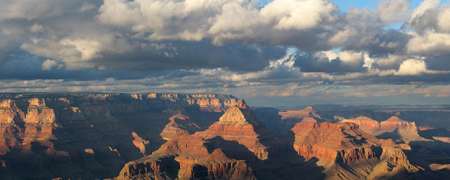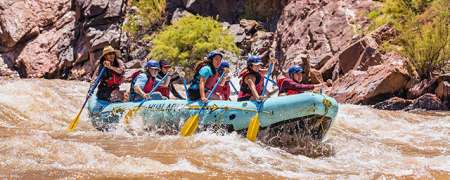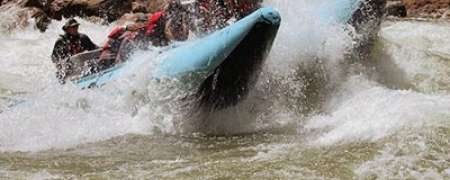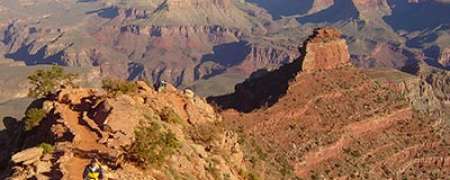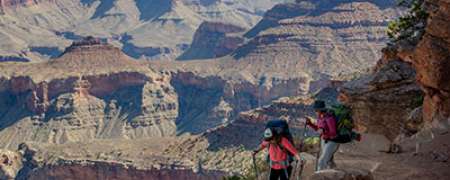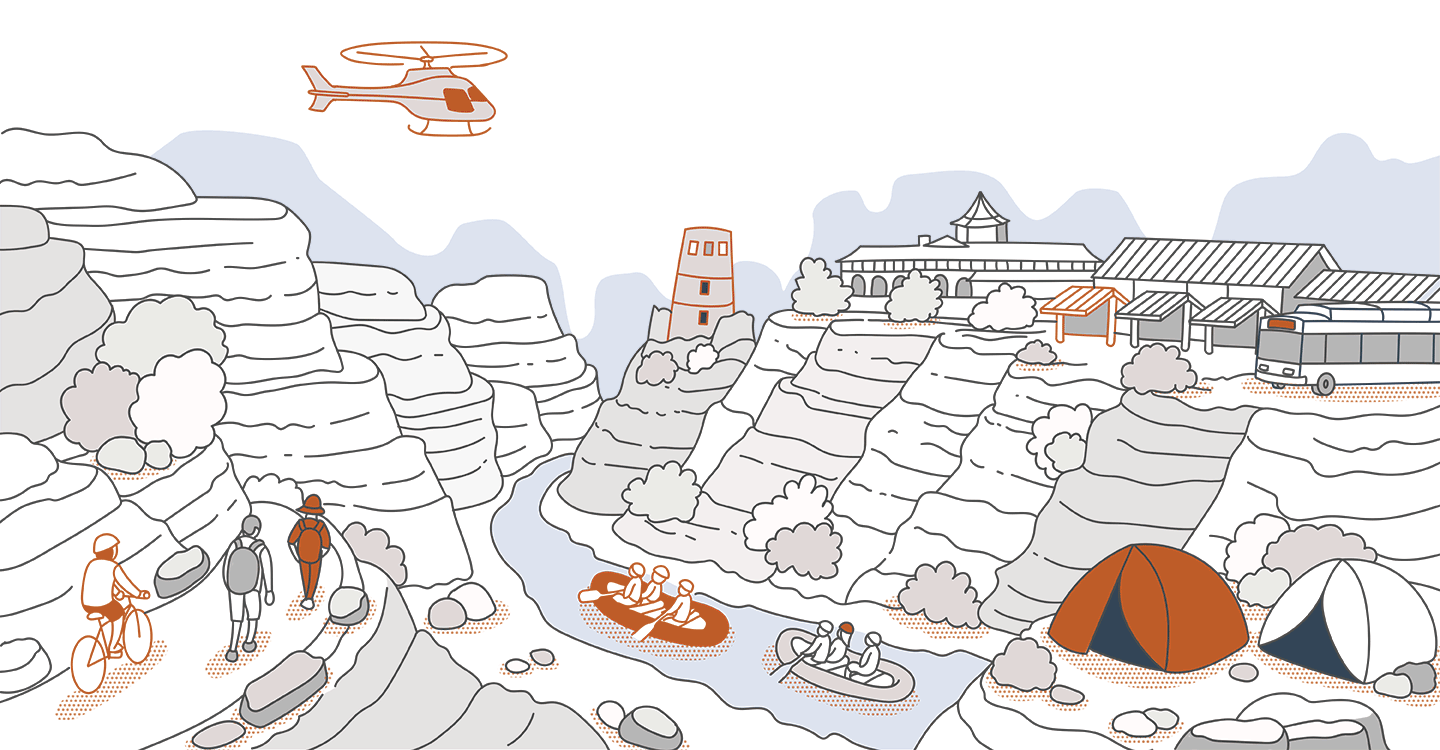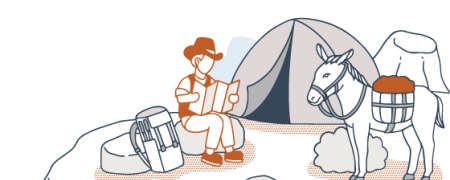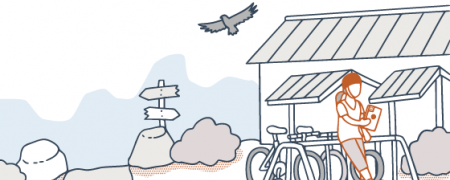List of Grand Canyon Waterfalls
Havasupai Area Waterfalls
Grand Canyon’s famous turquoise waterfalls are located on Havasupai Tribal land and are not inside the national park. The hike to the Havasu Falls Campground is hot and strenuous—10-miles one way—and access to the area is by permit only, which must be acquired in advance from the tribe. Permits are in high demand year-round so make sure to plan for your trip well in advance. For those that aren’t up to the hike (or camping for that matter), the tribe offers great alternatives including mule or helicopter rides, as well as a rustic motel in Supai Village at the bottom of Grand Canyon. This area is not only beautiful, but is also sacred to the tribe; Havasupai means people of the blue-green waters.
New Navajo Falls
When flash floods tore through Havasupai Tribal land in 2008, many feared that the large amounts of damage would never be repaired. While it did take a while to reopen, visitors were delighted to find that this beloved part of the canyon remains just as beautiful as it once was. Although Navajo Falls was noticeably changed by the floods it is still well worth a visit to see the multiple cascades pouring over the rocks into the turquoise pools below. Because this is one of the less famous waterfalls in the Havasu area, it is a good choice if you’re looking for a less crowded area to hang out.
50 Foot Falls
On the way to the Havasu campground this waterfall is a beautiful series of cascades that fall into a great swimming hole below. Because of the location of the falls in the canyon, this is a nice sunny swim spot for most of the day and is much less crowded than other Havasu area waterfalls.
Havasu Falls
Havasu Falls is the waterfall that everyone thinks of when they think of Grand Canyon, a nearly 100-foot waterfall pouring over red rocks into an, other-worldly turquoise colored pool below. The spectacular color of the water is due to the fact that the spring waters that feed Havasu Creek contain large amounts of calcium carbonate (the same harmless chemical that makes up chalk or eggshells); the calcium carbonate reflects the sunlight and creates the unique water color that this area is known for. As the area’s namesake, this is certainly the most crowded waterfall to visit but the series of terraces and small cascades below the falls allow groups to spread out and soak in the waters downstream. The open area around the base of the falls lends itself perfectly to getting great photos without any scrambling to get just the right angle, which explains why you’ve certainly seen photos of this particular waterfall before!
Mooney Falls
Yet another spectacular cascade in the area, this waterfall is closest to the campground. It is also the tallest waterfall, measuring in at an impressive 190 feet. In order to access it, hikers have to climb on a series of wooden ladders affixed to the rocks and there are sections of chains along the route as well. All of these can be wet and slippery, so this is not a hike for those scared of heights. The payoff for the adventurous climb is an eye level view of the falls along the way.
Beaver Falls
This waterfall is a long day hike (8-miles roundtrip) from the Havasu Falls Campground but the incredible series of travertine terraces below the waterfall is certainly the draw. You access the falls by first passing Mooney Falls and then continuing along Havasu Creek until you get to the day use area. Because of the additional mileage to get here, this is a much quieter area for those looking to escape from the Havasu crowds. Learn more about all of the waterfalls and attractions in this area on the Havasupai Tribes official website.
Grand Canyon National Park Waterfalls
Vasey’s Paradise
This perennial waterfall is fed by groundwater that emerges from the Redwall limestone cliffs above the Colorado River. This area is viewable only via a river trip (River mile 32) but visitors are not allowed to leave their boats and approach the waterfall itself—the small endangered Kanab ambersnail lives among the vegetation around the waterfall and their protected status has prompted the park to close the area to people. There is lush vegetation growing on the walls adjacent to the falls giving this area the feel of an oasis.
Roaring Springs
One of the few waterfalls that can realistically be reached via a day hike, Roaring Springs is not only a beautiful water-filled paradise after a long trek, but it also serves the important purpose of providing all of the drinking water to visitors on both the North and South Rims. Accessed via the North Kaibab Trail from the North Rim, the hike is rated as difficult at 9.4 miles roundtrip with 3,500 feet elevation change along the way; the National Park Service does not recommend making the hike in one day, although seasoned hikers certainly can and do. The beautiful spring waters flow year-round. While the National Park Service recommends that you filter all drinking water, many visitors drink water directly from the falling waters of the spring with the assumption that it comes out perfectly filtered by nature.
Ribbon Falls
This waterfall is also located off of the North Kaibab Trail, but this waterfall is too far to be considered a day hike (8.4 miles, 4,500+ feet elevation from the trailhead) so it is visited by Rim to Rim hikers as a lovely side-trip along the way. Only 20 minutes off the main trail, the Ribbon Falls Trail ends right at the falls itself. The upper falls pour over a cliff and then lands on a rounded rock formation below that is considered the lower falls. The rock behind the lower falls is startingly colorful in the desert landscape, coated in a thick mat of moss and greenery. Hikers can stand under the lower falls to cool down or just soak their weary feet in the cool pool of water.
Cheyava Falls
Although this is not a waterfall that most visitors have seen photographs of before their Grand Canyon adventure, this is actually the tallest waterfall in the canyon measuring in at an incredible 800 feet. “Discovered” in 1903 by the canyon’s famous Kold Brothers, the name of the waterfall shows that it was known long before pioneers came to the canyon—Cheyava is a Hopi word meaning “intermittent waters.” This area is most heavily visited in March and April after the previous winter’s snowmelt has begun to pour out of the highest part of the waterfall; once the snowmelt dries up, so does the upper part of the waterfall. The lower portion of the waterfall is perennial however, so if you’re staying overnight at Phantom Ranch, this 5-mile oneway hike will lead you to water not matter what time of year that you go. Accessed via the Clear Creek Trail, off of the North Kaibab Trail just north of Phantom Ranch.
Elves Chasm
One of the must-see waterfalls while on a Colorado River rafting trip, this waterfall is popular because the hike is relatively easy (3-miles roundtrip, hardly any elevation) and leads to the magical grotto of Elves Chasm. The trail to the waterfall involves a lot of bouldering and scrambling, and some of it is slippery too. That said, if you’ve made it this far on a river trip, you’ve probably hiked through worse! Once you’re in the shaded grotto, there is a cave behind the waterfall that you can climb into and the jump off into the pool below—any river guide can show you the way to do it. It is not recommended that you drink the water here, even if you’re filtering it.
Stone Creek Falls
The perfect waterfall hike for both those who are looking to take it easy or those looking for a little more of an adventure, the hike to Stone Creek is accessed via a Colorado River trip at river mile 132.5. The first falls is a short and easy hike from the river and makes a lovely place to “shower” in the cascade or sit and enjoy a book or nap while the rest of the group treks to the upper falls. The upper falls is extremely photogenic—a tall cascade pouring into a shaded slot canyon.
Thunder River Falls
Thunder River can be reached via an overnight backpacking trip into the canyon on the Bill Hall and Thunder River trails, but it is a long, hot and arduous hike for those willing to make the trek. The easier option is to access the falls from a Colorado River trip via the Tapeats Creek drainage at river mile 134.3. Either way, you’ll be glad you made the journey; the sheer amount of water pouring out the rock defies logic in the dry, desert surroundings. The lush green oasis around Thunder River is a great place to relax while you hear the immense amount of spring water thundering out of the canyon walls.
Deer Creek Falls
This waterfall is so easy to access via a Colorado River raft trip that everyone stops here. While you’ll never have the place to yourself, it is popular for good reason. Only a couple of hundred yards from the Colorado, Deer Creek Falls pours as a single stream out of the slot canyon above. A swim in the pool is brisk and refreshing, as is sitting next to it and experiencing the amazing air conditioner effect of the mist drifting off of the falls. You can opt to hike above the falls to see the “patio” area where Deer Creek winds its way through the narrow slot canyon that is eventually pours out of. To protect sensitive cultural resources, the National Park Service has closed this area to climbing and rappelling, with or without equipment.
Travertine Cavern Falls
This waterfall is only accessible on “Diamond down” river trips—those that travel past the Diamond Creek takeout at the end of Lower Grand Canyon to continue on to Lake Mead or via a Hualapai River Runner whitewater day trip. Either way, Travertine Cavern is accessible via a moderate hike from the Colorado River that includes some fun sections of rope and board ladders next to cascades. The cavern itself boasts surprisingly cooler air temperatures and the sounds of the waterfall echoing off the cliffs is soothing as you relax in one of the pools of water below it.
